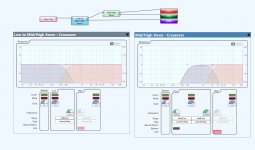Hi, just looking for some confirmation that my understanding is correct.
Say you have a 4 Ohm Woofer, 4 Ohm Mid, and 4 Ohm Tweeter
If creating Linkwitz-Riley crossovers for each component, you would calculate based on them being 4 Ohm.
Does that stay true if I then wire the Mid and Tweeter as series (8 Ohm), and then wire that to the woofer as parallel? Resulting in 2.67 Ohm?
Or, do I need to calculate the crossovers for the mid & tweeter as 8 ohm as they will be part of an 8 Ohm circuit before being tied into the woofer?
Thanks!
Say you have a 4 Ohm Woofer, 4 Ohm Mid, and 4 Ohm Tweeter
If creating Linkwitz-Riley crossovers for each component, you would calculate based on them being 4 Ohm.
Does that stay true if I then wire the Mid and Tweeter as series (8 Ohm), and then wire that to the woofer as parallel? Resulting in 2.67 Ohm?
Or, do I need to calculate the crossovers for the mid & tweeter as 8 ohm as they will be part of an 8 Ohm circuit before being tied into the woofer?
Thanks!
To get this straight.. you want to create a series crossover for your mid and tweeter, then a parallel crossover between this and the woofer?
I'd still consider it 4 ohm, broadly speaking.
I'd still consider it 4 ohm, broadly speaking.
Yes, that is correct. So just think treat everything as 4 Ohm when calculating the Linkwitz Riley aspects?
Even though the mid and tweeter look to be in series, the overall result differs with frequency. At the lower mid frequencies, the tweeter is effectively out of the picture, just like dealing with the mid on its own.
'treat everything as 4 Ohm when calculating' - no, the impedance of a loudspeaker varies with frequency, use the actual value for the driver at the frequency you are calculating for. (Look at the manufacturer's data sheet, which usually includes an impedance plot)
I certainly could see that being more accurate, but my drivers do not include that information. Would using the Re spec be more accurate?
Your question is answered in the first section of this post:
A Speaker Maker's Journey: Crossover Basics - Impedance
A Speaker Maker's Journey: Crossover Basics - Impedance
Hi, I have no experience (or desire) to work with passive xovers and impedance's.
But 3 way xovers, be they passive IIR or active IIR, deserve to be cascaded to minimize ripple.
Here's a schematic with xover points at 300Hz and 2kHz, using LR 24's to illustrate.
If i were to go passive, I'd try to think through the impedance implications in the schematic.
But 3 way xovers, be they passive IIR or active IIR, deserve to be cascaded to minimize ripple.
Here's a schematic with xover points at 300Hz and 2kHz, using LR 24's to illustrate.
If i were to go passive, I'd try to think through the impedance implications in the schematic.
Attachments
Last edited:
- Home
- Loudspeakers
- Multi-Way
- 3 Way Crossover / Series Parallel Question
